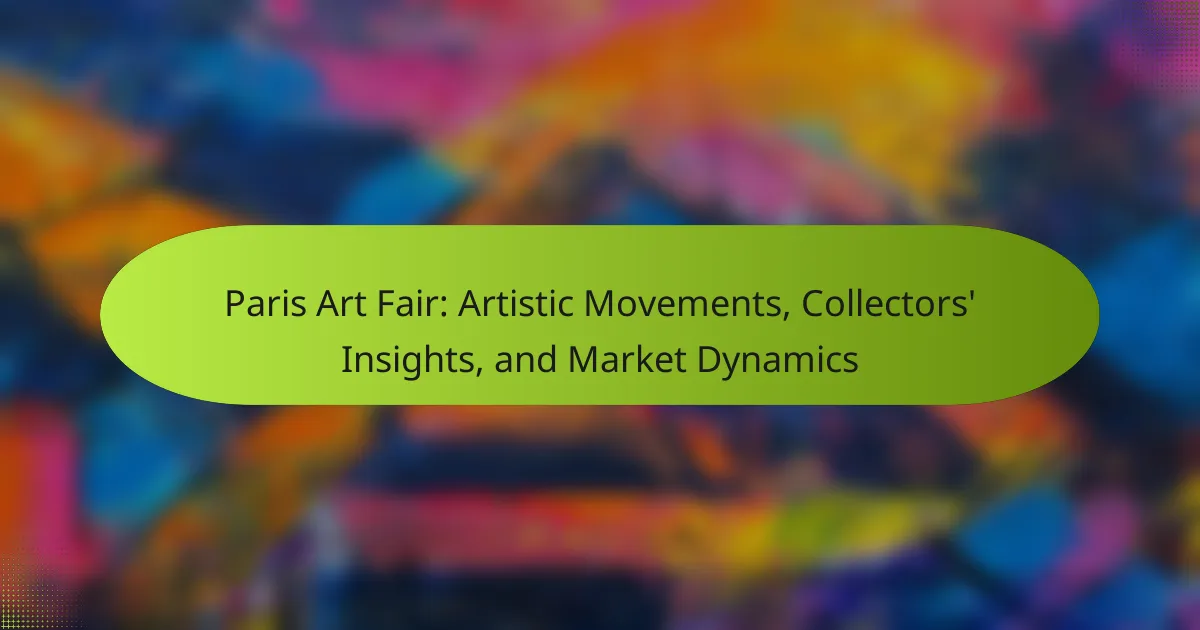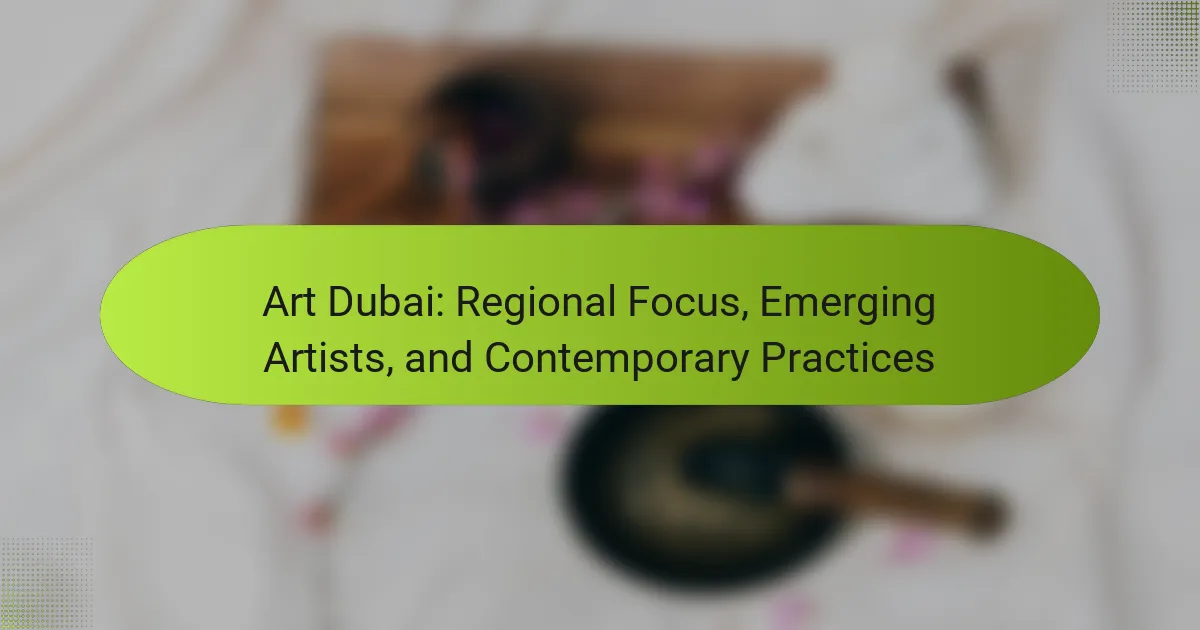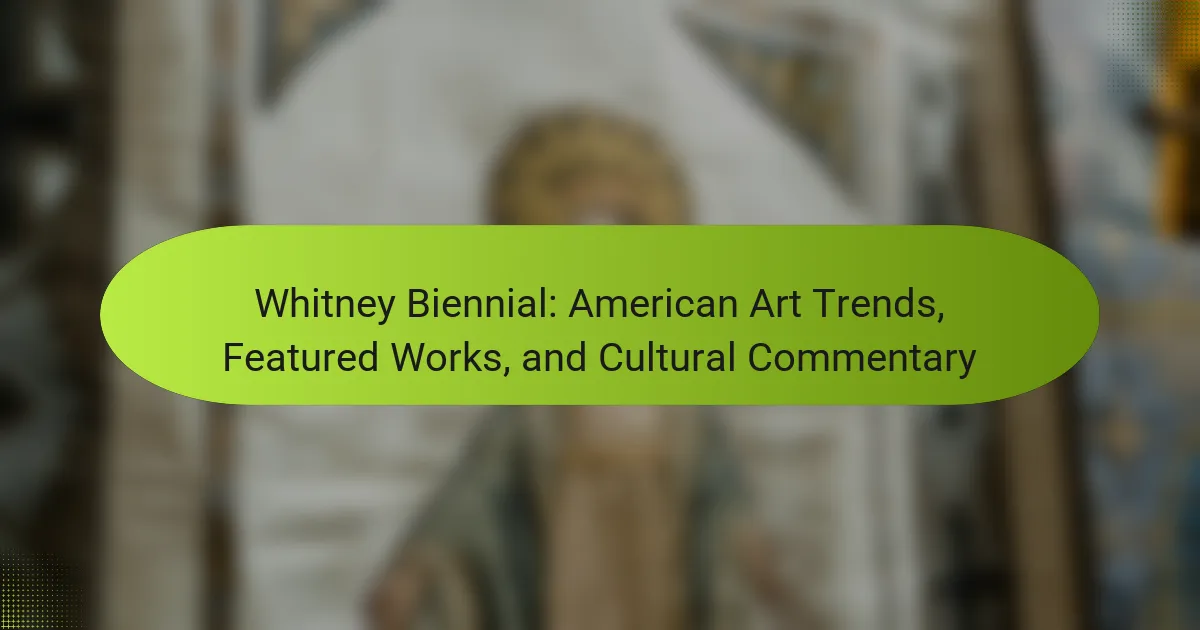Understanding Documenta’s historical importance enhances appreciation for contemporary art. This article examines its innovative curatorial concepts, the engagement strategies employed for visitors, and the legacy of influential artists. It also addresses the challenges Documenta faces in balancing tradition and modern relevance.
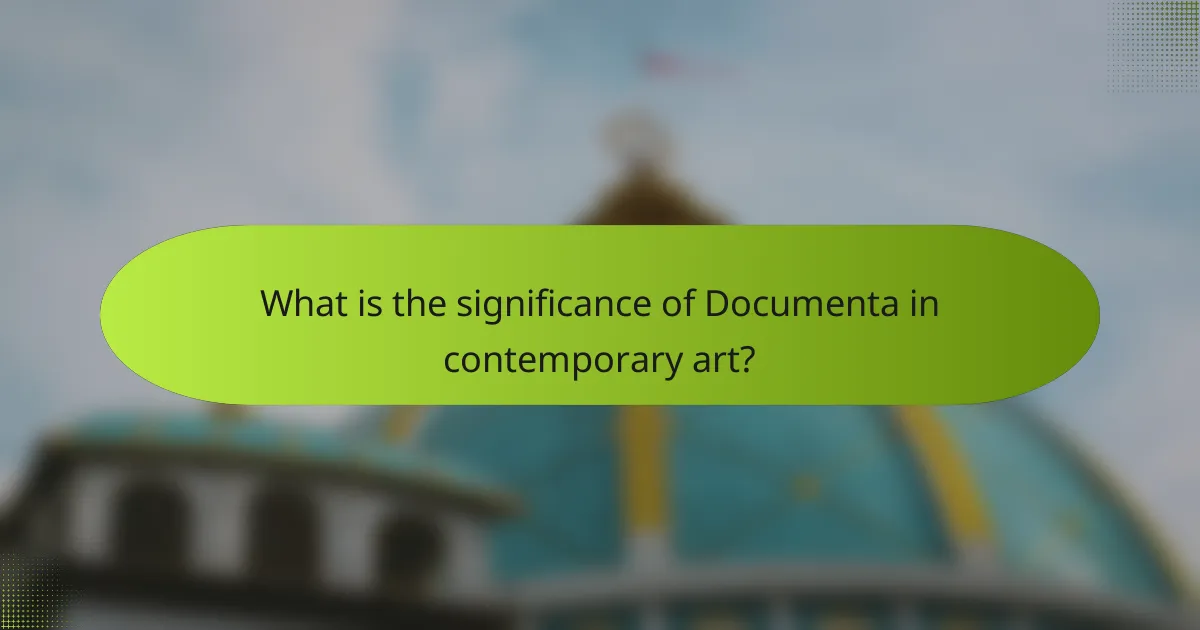
What is the significance of Documenta in contemporary art?
Documenta plays a crucial role in contemporary art by showcasing innovative curatorial concepts and fostering visitor engagement. Since its inception in 1955, it has served as a platform for artists to explore and challenge socio-political themes. Documenta’s significance lies in its ability to reflect global art trends while promoting dialogue among diverse audiences. The event encourages critical thinking and cultural exchange, making it a pivotal moment in the contemporary art calendar.
How has Documenta influenced artistic movements globally?
Documenta has significantly influenced global artistic movements by promoting innovative curatorial concepts and fostering international dialogue. Its emphasis on contemporary issues has inspired artists worldwide to explore new forms and themes. Documenta’s unique attribute lies in its commitment to social engagement, which encourages artists to address pressing global challenges. This approach has led to the emergence of diverse artistic expressions that resonate across cultures, shaping contemporary art practices. As a result, Documenta has become a pivotal platform for redefining artistic boundaries and encouraging critical discourse in the global art community.
In what ways does Documenta reflect socio-political contexts?
Documenta reflects socio-political contexts through its curatorial themes and artist selections. It engages with contemporary issues like migration, identity, and climate change, fostering critical dialogue. The exhibition’s evolving nature showcases diverse perspectives, emphasizing the role of art in societal discourse. Documenta’s historical significance lies in its ability to mirror and challenge prevailing socio-political narratives, making it a vital platform for cultural reflection.
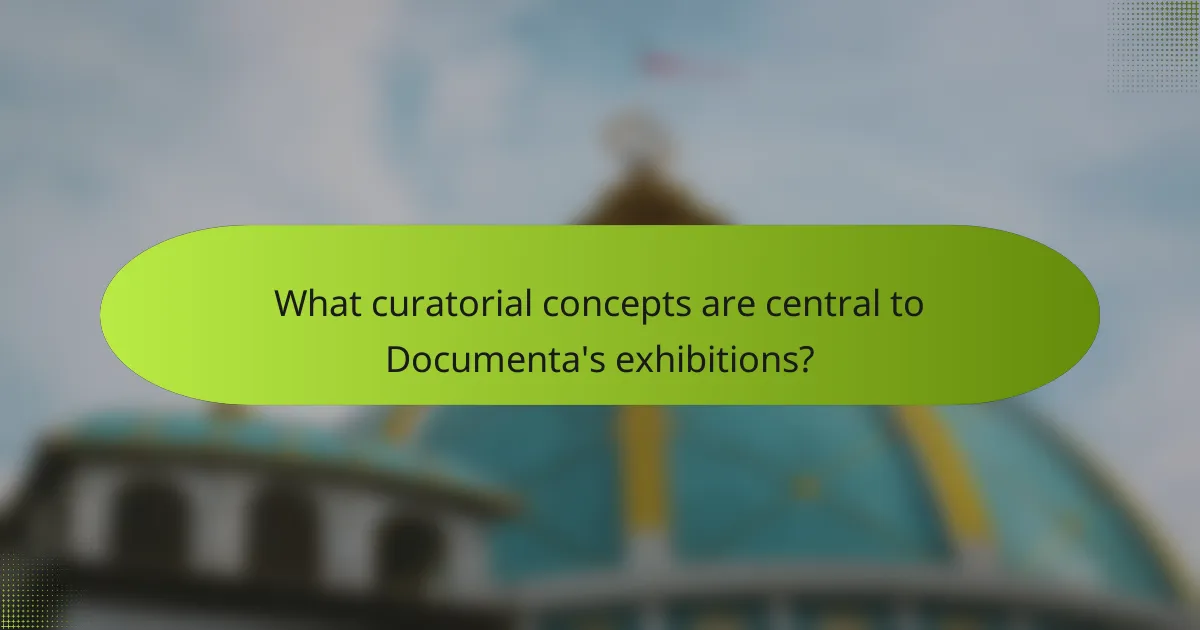
What curatorial concepts are central to Documenta’s exhibitions?
Documenta’s exhibitions emphasize concepts like the intersection of art and politics, global perspectives, and community engagement. These curatorial ideas reflect the event’s commitment to challenging traditional narratives and fostering dialogue among diverse audiences. The integration of contemporary issues and historical context enriches visitor experiences and encourages critical thinking. Documenta continually evolves, adapting its themes to resonate with current global challenges while maintaining its core mission of artistic exploration.
How do curatorial themes evolve across different Documenta editions?
Curatorial themes at Documenta evolve by responding to contemporary societal issues and artistic movements. Each edition reflects the cultural context of its time, showcasing diverse perspectives.
For instance, Documenta 13 emphasized the impact of globalization, while Documenta 14 explored the role of art in public discourse. This evolution highlights the unique attributes of each edition, fostering visitor engagement through relevant themes.
As a result, the historical importance of Documenta lies in its adaptability and relevance, making it a significant platform for artists and audiences alike.
What role do collaborative practices play in Documenta’s curation?
Collaborative practices are essential in Documenta’s curation, fostering diverse artistic expressions and dialogue. They enhance the exhibition’s relevance and inclusivity by integrating voices from various cultural backgrounds. This approach not only enriches the visitor experience but also reflects contemporary societal issues, making art a platform for collective engagement. Documenta’s commitment to collaboration showcases unique attributes, such as co-curated projects and participatory installations, which differentiate it from other art events.

How does Documenta engage with its audience?
Documenta engages its audience through interactive installations, educational programs, and community involvement. These initiatives foster a deeper connection between the artworks and visitors. For example, workshops and guided tours enhance understanding of contemporary art. Additionally, Documenta encourages feedback and participation, allowing audiences to influence future exhibitions. This approach cultivates a dynamic relationship, making art accessible and relevant.
What innovative visitor experiences are offered at Documenta?
Documenta offers innovative visitor experiences through interactive installations, guided tours, and participatory workshops. These experiences engage audiences and encourage dialogue about contemporary art. Unique features include immersive environments that challenge perceptions and foster connections among visitors. Additionally, curated events often incorporate local community involvement, enhancing cultural relevance.
How does Documenta utilize technology to enhance visitor interaction?
Documenta employs technology to enhance visitor interaction through immersive digital experiences and interactive installations. These innovations allow visitors to engage with artworks in novel ways, fostering deeper connections. For instance, augmented reality applications enable users to visualize art in a personal context. Additionally, online platforms facilitate virtual tours, broadening accessibility for global audiences. This integration of technology not only enriches the visitor experience but also aligns with Documenta’s commitment to contemporary curatorial practices.
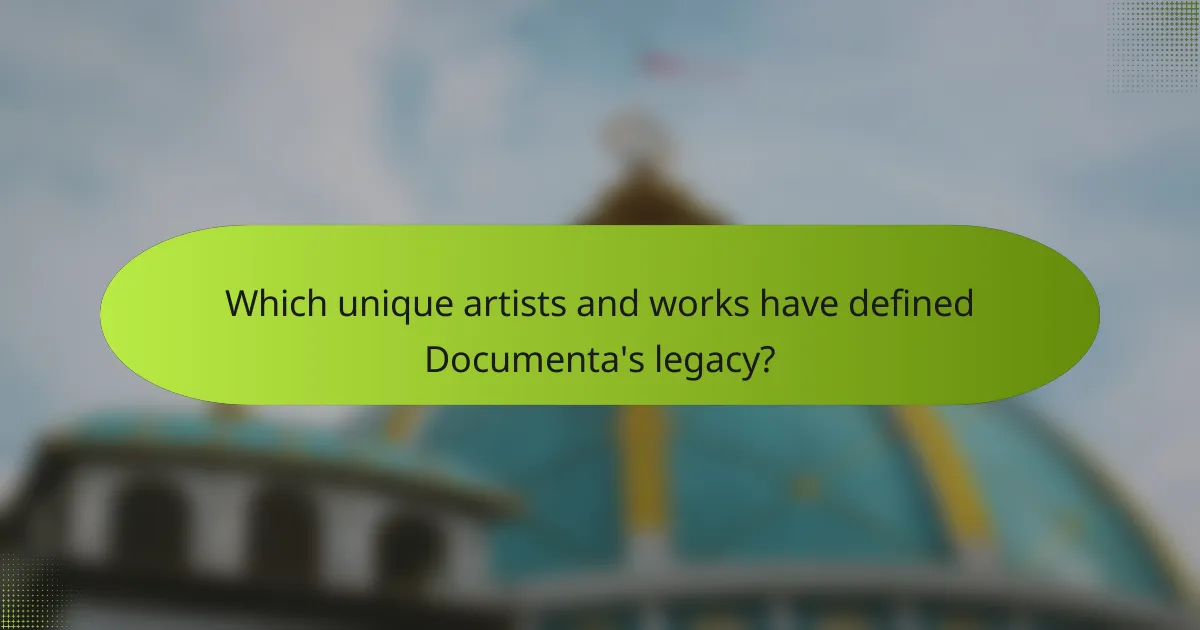
Which unique artists and works have defined Documenta’s legacy?
Documenta’s legacy is defined by unique artists and significant works that challenge conventional narratives. Notable figures include Joseph Beuys, whose socially engaged art reshaped public discourse, and Tadeusz Kantor, known for his innovative theatrical installations. Other influential contributions come from artists like Marina Abramović, whose performances explore endurance and vulnerability, and Ai Weiwei, who addresses political themes through diverse mediums. Each of these artists has left an indelible mark on Documenta, reflecting its commitment to contemporary issues and global dialogues.
What are the standout installations from recent Documenta events?
Recent Documenta events have showcased standout installations that emphasize contemporary art’s role in society. Notable examples include “The Black Archive,” which explores historical narratives, and “The Garden of Ideas,” promoting sustainability. These installations engage visitors through interactive elements and thought-provoking themes. Each reflects Documenta’s unique curatorial approach, focusing on social issues and cultural dialogue.
How do artist collaborations shape the identity of Documenta?
Artist collaborations significantly influence Documenta’s identity by fostering diverse perspectives and innovative practices. These partnerships create a dynamic dialogue that reflects contemporary issues and artistic trends. Collaborations often highlight unique attributes of artists, enhancing the exhibition’s relevance and engagement. As a result, Documenta evolves into a platform for critical discourse, shaping its historical importance and curatorial concepts.

What challenges does Documenta face in the modern art landscape?
Documenta faces challenges such as balancing historical significance with contemporary relevance, engaging diverse audiences, and addressing funding and political pressures. The tension between traditional curatorial concepts and modern artistic expression complicates its mission. Additionally, competition from other art events impacts visitor engagement.
How is Documenta adapting to changing audience expectations?
Documenta is adapting to changing audience expectations by enhancing visitor engagement through innovative curatorial concepts. This includes integrating interactive elements and diverse perspectives to resonate with a broader audience. Documenta has shifted focus to contemporary social issues, reflecting current global dialogues. As a result, the exhibition fosters deeper connections and encourages active participation, aligning with evolving cultural interests.
What are the financial and logistical hurdles for Documenta?
Documenta faces significant financial and logistical hurdles, including funding limitations and resource allocation challenges. Financially, securing sponsorship and government support is crucial, as operational costs are high. Logistically, managing venue spaces and coordinating with artists adds complexity. These factors impact planning and execution, influencing visitor engagement and overall success.

What are the best practices for engaging with Documenta’s offerings?
Engaging with Documenta’s offerings involves understanding its historical importance, curatorial concepts, and fostering visitor interaction. To maximize the experience, consider these best practices:
1. Research the historical context of Documenta to appreciate its evolution and significance.
2. Explore curatorial concepts to grasp the thematic focus of each exhibition.
3. Participate in guided tours or workshops to enhance understanding and engagement.
4. Utilize digital resources and social media platforms for broader insights and community interaction.
How can visitors maximize their experience at Documenta?
Visitors can maximize their experience at Documenta by planning their visit, engaging with the art, and participating in events.
Firstly, researching the curatorial concepts and featured artists enhances understanding and appreciation of the exhibits. Secondly, taking part in guided tours or discussions provides deeper insights into the artworks and their historical significance. Lastly, attending workshops or performances fosters a more interactive experience, allowing visitors to engage creatively with the themes presented.
What common pitfalls should visitors avoid when attending Documenta?
Visitors should avoid common pitfalls such as neglecting to plan their visit, ignoring exhibition guidelines, and underestimating the time needed for exploration.
Planning is crucial; many underestimate the scale of Documenta, leading to rushed experiences. Exhibitions often have specific guidelines; failing to follow them can detract from engagement. Additionally, Documenta features extensive installations requiring ample time to appreciate fully, so allocate sufficient hours for a meaningful visit.
